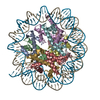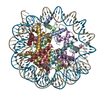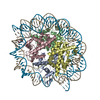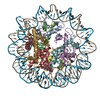+ Open data
Open data
- Basic information
Basic information
| Entry | Database: PDB / ID: 7d69 | ||||||||||||||||||||||||||||||||||||
|---|---|---|---|---|---|---|---|---|---|---|---|---|---|---|---|---|---|---|---|---|---|---|---|---|---|---|---|---|---|---|---|---|---|---|---|---|---|
| Title | Cryo-EM structure of the nucleosome containing Giardia histones | ||||||||||||||||||||||||||||||||||||
 Components Components |
| ||||||||||||||||||||||||||||||||||||
 Keywords Keywords | NUCLEAR PROTEIN / nucleosome / chromatin / histone / Giardia lamblia | ||||||||||||||||||||||||||||||||||||
| Function / homology |  Function and homology information Function and homology informationstructural constituent of chromatin / nucleosome / protein heterodimerization activity / DNA binding / nucleus Similarity search - Function | ||||||||||||||||||||||||||||||||||||
| Biological species |  Giardia intestinalis (eukaryote) Giardia intestinalis (eukaryote)synthetic construct (others) | ||||||||||||||||||||||||||||||||||||
| Method | ELECTRON MICROSCOPY / single particle reconstruction / cryo EM / Resolution: 3.57 Å | ||||||||||||||||||||||||||||||||||||
 Authors Authors | Sato, S. / Takizawa, Y. / Kurumizaka, H. | ||||||||||||||||||||||||||||||||||||
| Funding support |  Japan, 1items Japan, 1items
| ||||||||||||||||||||||||||||||||||||
 Citation Citation |  Journal: Nucleic Acids Res / Year: 2021 Journal: Nucleic Acids Res / Year: 2021Title: Cryo-EM structure of the nucleosome core particle containing Giardia lamblia histones. Authors: Shoko Sato / Yoshimasa Takizawa / Fumika Hoshikawa / Mariko Dacher / Hiroki Tanaka / Hiroaki Tachiwana / Tomoya Kujirai / Yukari Iikura / Cheng-Han Ho / Naruhiko Adachi / Indu Patwal / ...Authors: Shoko Sato / Yoshimasa Takizawa / Fumika Hoshikawa / Mariko Dacher / Hiroki Tanaka / Hiroaki Tachiwana / Tomoya Kujirai / Yukari Iikura / Cheng-Han Ho / Naruhiko Adachi / Indu Patwal / Andrew Flaus / Hitoshi Kurumizaka /   Abstract: Giardia lamblia is a pathogenic unicellular eukaryotic parasite that causes giardiasis. Its genome encodes the canonical histones H2A, H2B, H3, and H4, which share low amino acid sequence identity ...Giardia lamblia is a pathogenic unicellular eukaryotic parasite that causes giardiasis. Its genome encodes the canonical histones H2A, H2B, H3, and H4, which share low amino acid sequence identity with their human orthologues. We determined the structure of the G. lamblia nucleosome core particle (NCP) at 3.6 Å resolution by cryo-electron microscopy. G. lamblia histones form a characteristic NCP, in which the visible 125 base-pair region of the DNA is wrapped in a left-handed supercoil. The acidic patch on the G. lamblia octamer is deeper, due to an insertion extending the H2B α1 helix and L1 loop, and thus cannot bind the LANA acidic patch binding peptide. The DNA and histone regions near the DNA entry-exit sites could not be assigned, suggesting that these regions are asymmetrically flexible in the G. lamblia NCP. Characterization by thermal unfolding in solution revealed that both the H2A-H2B and DNA association with the G. lamblia H3-H4 were weaker than those for human H3-H4. These results demonstrate the uniformity of the histone octamer as the organizing platform for eukaryotic chromatin, but also illustrate the unrecognized capability for large scale sequence variations that enable the adaptability of histone octamer surfaces and confer internal stability. | ||||||||||||||||||||||||||||||||||||
| History |
|
- Structure visualization
Structure visualization
| Movie |
 Movie viewer Movie viewer |
|---|---|
| Structure viewer | Molecule:  Molmil Molmil Jmol/JSmol Jmol/JSmol |
- Downloads & links
Downloads & links
- Download
Download
| PDBx/mmCIF format |  7d69.cif.gz 7d69.cif.gz | 262.4 KB | Display |  PDBx/mmCIF format PDBx/mmCIF format |
|---|---|---|---|---|
| PDB format |  pdb7d69.ent.gz pdb7d69.ent.gz | 194.5 KB | Display |  PDB format PDB format |
| PDBx/mmJSON format |  7d69.json.gz 7d69.json.gz | Tree view |  PDBx/mmJSON format PDBx/mmJSON format | |
| Others |  Other downloads Other downloads |
-Validation report
| Arichive directory |  https://data.pdbj.org/pub/pdb/validation_reports/d6/7d69 https://data.pdbj.org/pub/pdb/validation_reports/d6/7d69 ftp://data.pdbj.org/pub/pdb/validation_reports/d6/7d69 ftp://data.pdbj.org/pub/pdb/validation_reports/d6/7d69 | HTTPS FTP |
|---|
-Related structure data
| Related structure data |  30591MC M: map data used to model this data C: citing same article ( |
|---|---|
| Similar structure data |
- Links
Links
- Assembly
Assembly
| Deposited unit | 
|
|---|---|
| 1 |
|
- Components
Components
-Protein , 4 types, 8 molecules AEBFDHCG
| #1: Protein | Mass: 16639.574 Da / Num. of mol.: 2 Source method: isolated from a genetically manipulated source Source: (gene. exp.)  Giardia intestinalis (eukaryote) / Gene: DHA2_154455 / Production host: Giardia intestinalis (eukaryote) / Gene: DHA2_154455 / Production host:  #2: Protein | Mass: 11407.195 Da / Num. of mol.: 2 Source method: isolated from a genetically manipulated source Source: (gene. exp.)  Giardia intestinalis (eukaryote) / Gene: DHA2_135001, DHA2_154716, GSB_155602 / Production host: Giardia intestinalis (eukaryote) / Gene: DHA2_135001, DHA2_154716, GSB_155602 / Production host:  #3: Protein | Mass: 14903.089 Da / Num. of mol.: 2 Source method: isolated from a genetically manipulated source Source: (gene. exp.)  Giardia intestinalis (eukaryote) / Gene: DHA2_151009 / Production host: Giardia intestinalis (eukaryote) / Gene: DHA2_151009 / Production host:  #4: Protein | Mass: 14188.249 Da / Num. of mol.: 2 Source method: isolated from a genetically manipulated source Source: (gene. exp.)  Giardia intestinalis (eukaryote) / Production host: Giardia intestinalis (eukaryote) / Production host:  |
|---|
-601L DNA (145- ... , 2 types, 2 molecules IJ
| #5: DNA chain | Mass: 44761.523 Da / Num. of mol.: 1 Source method: isolated from a genetically manipulated source Source: (gene. exp.) synthetic construct (others) / Production host:  |
|---|---|
| #6: DNA chain | Mass: 44752.508 Da / Num. of mol.: 1 Source method: isolated from a genetically manipulated source Source: (gene. exp.) synthetic construct (others) / Production host:  |
-Details
| Has protein modification | N |
|---|
-Experimental details
-Experiment
| Experiment | Method: ELECTRON MICROSCOPY |
|---|---|
| EM experiment | Aggregation state: PARTICLE / 3D reconstruction method: single particle reconstruction |
- Sample preparation
Sample preparation
| Component | Name: Nucleosome / Type: COMPLEX / Entity ID: all / Source: RECOMBINANT |
|---|---|
| Source (natural) | Organism:  Giardia intestinalis (eukaryote) Giardia intestinalis (eukaryote) |
| Source (recombinant) | Organism:  |
| Buffer solution | pH: 7.5 |
| Specimen | Embedding applied: NO / Shadowing applied: NO / Staining applied: NO / Vitrification applied: YES |
| Vitrification | Cryogen name: ETHANE |
- Electron microscopy imaging
Electron microscopy imaging
| Experimental equipment |  Model: Titan Krios / Image courtesy: FEI Company |
|---|---|
| Microscopy | Model: FEI TITAN KRIOS |
| Electron gun | Electron source:  FIELD EMISSION GUN / Accelerating voltage: 300 kV / Illumination mode: FLOOD BEAM FIELD EMISSION GUN / Accelerating voltage: 300 kV / Illumination mode: FLOOD BEAM |
| Electron lens | Mode: BRIGHT FIELD |
| Image recording | Electron dose: 64 e/Å2 / Film or detector model: GATAN K3 BIOQUANTUM (6k x 4k) |
- Processing
Processing
| Software | Name: PHENIX / Version: 1.15.2_3472: / Classification: refinement | ||||||||||||||||||||||||
|---|---|---|---|---|---|---|---|---|---|---|---|---|---|---|---|---|---|---|---|---|---|---|---|---|---|
| EM software | Name: PHENIX / Category: model refinement | ||||||||||||||||||||||||
| CTF correction | Type: PHASE FLIPPING AND AMPLITUDE CORRECTION | ||||||||||||||||||||||||
| 3D reconstruction | Resolution: 3.57 Å / Resolution method: FSC 0.143 CUT-OFF / Num. of particles: 194041 / Symmetry type: POINT | ||||||||||||||||||||||||
| Atomic model building | Protocol: FLEXIBLE FIT / Space: REAL | ||||||||||||||||||||||||
| Refine LS restraints |
|
 Movie
Movie Controller
Controller












 PDBj
PDBj






































